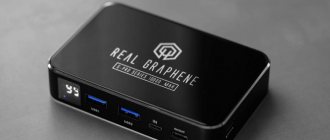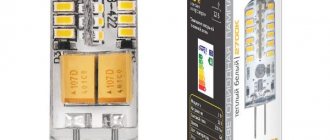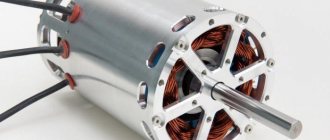Ionistors are electrochemical double-layer capacitors or supercapacitors. Their metal electrodes are coated with highly porous activated carbon, traditionally made from coconut shells, but most commonly from carbon airgel, other nanocarbons, or graphene nanotubes. Between these electrodes there is a porous separator, which holds the electrodes from each other, when wound on a spiral, the whole thing is impregnated with electrolyte. Some innovative forms of supercapacitor have a solid electrolyte. They replace traditional batteries in uninterruptible power supplies up to trucks, where they use a capacitor as a power source.
Principle of operation
The ionistor uses the action of a double layer formed at the interface between carbon and electrolyte. Activated carbon is used as an electrode in solid form, and electrolyte in liquid form. When these materials come into contact with each other, the positive and negative poles are distributed relative to each other over a very short distance. When an electric field is applied, an electric double layer is used as the main structure, which is formed near the surface of the coal in the electrolytic liquid.
Design advantage:
- Provides capacity in a small device, there is no need for special charging circuits to control during discharging in devices that use a supercapacitor.
- Overcharging or excessively frequent discharging does not negatively affect service life as with standard batteries.
- The technology is extremely “clean” from an environmental point of view.
- There are no problems with unstable contacts, as with conventional batteries.
Design disadvantages:
- The operating time is limited due to the use of electrolyte in devices that use an ionistor.
- Electrolyte may leak if the capacitor is not used correctly.
- Compared to aluminum capacitors, these ionistors have high resistance and therefore cannot be used in AC circuits.
Taking advantage of the advantages described above, electrical supercapacitors are widely used in applications such as:
- Memory reservation for timers, programs, e-mobile power, etc.
- Video and audio equipment.
- Backup sources when replacing batteries for portable electronic equipment.
- Power supplies for equipment using solar cells, such as clocks and indicators.
- Starters for small and mobile engines.
How to charge an ionistor
To charge this element you need a power source. If it is present in the circuit, and the device works correctly, then the ionistor charges on its own and maintains the voltage transmitted from the battery or electrical network. If you need to charge the device yourself, then the circuit described below will do.
Charging connection example
The device is powered from a 12-volt adapter. A voltage and current regulator is then used to regulate 5.5V to charge the cell. This voltage is applied to the capacitor through a MOSFET, which acts as a switch. It closes only when the voltage in the ionistor drops to 4.8 V.
Important! If the voltage rises, the transistor opens and charging stops.
Redox reactions
The charge accumulator is located at the interface between the electrode and the electrolyte. During the charging process, electrons move from the negative electrode to the positive electrode along the outer circuit. During a discharge, electrons and ions move in the opposite direction. There is no charge transfer in an EDLC supercapacitor. In this type of supercapacitor, a redox reaction occurs at the electrode, generating charges and transferring charge through the double layers of the structure, where a supercapacitor is used.
Due to the redox reaction occurring in this type, there is a potential for lower power density than EDLC because Faradaic systems are slower than non-Faradaic systems. In general, pseudocapacitors provide higher specific capacitance and energy density than EDLCs due to their faradeite system. However, the correct choice of supercapacitor depends on the application and availability.
History of the invention of the ionistor
In 1957, the American company General Electric patented a simple ionistor with a diesel generator, the electrodes of which were made of activated carbon. Theoretically, it was assumed that energy would accumulate in the pores of the electrode surface.
Supercapacitor
Already in 1966, Standard Oil of Ohio received a patent for a component that ensured energy storage in diesel power plants. Having suffered losses due to low sales of capacitors, the company transferred the rights to manufacture these devices to Nec. The new license holder was able to significantly increase demand for its product called a supercapacitor. The device significantly reduced the energy dependence of electronic memory, which stimulated the development of computer technology.
The year 1978 was marked by the appearance on the electrical market of the Gold Cap by the leading Japanese electric company Panasonic. This was already a higher quality device. Ionistors have found their application in electronic memory power supply systems.
In the same year, the first mention of what ionistors are in the USSR was published in the fifth issue of Radio magazine. The article described the first Soviet ionistor KI1-1. His device assumed a maximum charge volume of up to 50 farads. The disadvantage of the supercapacitor was its high internal resistance (IR), which prevented the full release of electrical energy.
Small BC supercapacitors appeared only in 1982. The new design was developed by PRI specialists for particularly powerful circuits where the PRI Ultracapacitor ionistor is used.
Important! Progress in improving supercapacitors will lead to the fact that ionistors will completely replace traditional batteries.
Graphene-based materials
The supercapacitor has the ability to charge quickly, much faster than a traditional battery, but it is not able to store as much energy as a battery because it has a lower energy density. Increased efficiency is achieved through the use of graphene and carbon nanotubes. In the future, they will help ionistors completely replace electrochemical batteries. Nanotechnology is the source of many innovations today, especially in the e-mobile.
Graphene increases the capacity of ionistors. This revolutionary material consists of sheets whose thickness can be limited by the thickness of a carbon atom and whose atomic structure is ultra-dense. Such characteristics can replace silicon in electronics. A porous separator is placed between two electrodes. However, variations in the storage mechanism and the choice of electrode material lead to different classifications of high-capacity supercapacitors:
- Electrochemical double-layer capacitors (EDLC), which for the most part use high-carbon carbon electrodes and store their energy by rapidly adsorption of ions at the electrode/electrolyte interface.
- Psuedo capacitors are based on the phagadic process of charge transfer on or near the surface of an electrode. In this case, conducting polymers and transition metal oxides remain the electrochemical active materials, for example, as in battery-powered electronic watches.
Flexible polymer devices
The supercapacitor captures and stores energy at high rates by forming electrochemical double layers of charges or through surface redox reactions, resulting in high power densities with long cycle stability, low cost and environmental protection. PDMS and PET are the mainly used substrates in the implementation of flexible supercapacitors. In the case of film, PDMS can create flexible and transparent thin-film capacitors in hours with high cyclic stability after 10,000 flex cycles.
Single-walled carbon nanotubes can be further incorporated into the PDMS film to further improve mechanical, electronic, and thermal stability. Likewise, conductive materials such as graphene and CNTs are also coated with PET films to achieve both high flexibility and electrical conductivity. Besides PDMS and PET, other polymeric materials are also attracting growing interest and are synthesized by various methods. For example, localized pulsed laser irradiation has been used to rapidly transform a primary surface into an electrically conductive porous carbon structure with a defined graphic.
Natural polymers such as nonwovens made from wood fibers and paper can also be used as substrates that are flexible and lightweight. CNTs are deposited on paper to produce a flexible CNT paper electrode. Due to the high flexibility of the paper substrate and good distribution of CNTs, the specific capacitance and power and energy density change less than 5% after bending for 100 cycles at a bending radius of 4.5 mm. In addition, due to higher mechanical strength and better chemical stability, bacterial nanocellulose papers are also used to make flexible supercapacitors, such as the Walkman cassette player.
Practical use of ionistors
Modern models of supercapacitors have begun to be used in the fields of transport and consumer electronics.
Vehicles
Recently, powerful ionistors have increasingly been integrated into the power supply circuit of electric vehicles.
Heavy and public transport
Electric buses have begun to appear on the streets of megacities around the world. In Moscow you can see public transport powered by the energy of on-board ionistors. Domestic electric buses entered the capital’s city routes in May of this year.
On heavy vehicles, supercapacitors are used as an auxiliary power source.
Cars
Leading manufacturers of electric vehicles, such as Tesla and Nissan, taking advantage of international exhibitions, each time present new models whose power systems are built on ionistors. The Russian prototype Yo-mobile uses a supercapacitor as its main energy source.
Automotive ionistor
Additional Information. On vehicles running on liquid fuel, ionistors began to be installed to ensure easy engine starting in the Far North.
Supercapacitor with battery for easier engine starting
Auto racing
To promote and advertise cars powered by ionistors, leading automakers constantly hold auto races in such cars. Spectators at such events show great interest in the prospects for the development of electric personal transport.
Consumer electronics
Supercapacitors have exploded into the consumer electronics space. They can be seen in backup power supplies for laptops and smartphones. Ionistors are built into the operating units of personal computers. They protect against data loss during emergency outages from a constant source of electricity.
Ionistor for uninterruptible power supply of PC
Supercapacitor Performance
It is defined in terms of electrochemical activity and chemical kinetic properties, namely: electron and ion kinetics (transport) within the electrodes and the efficiency of the rate of charge transfer to the electrode/electrolyte. Specific surface area, electrical conductivity, pore size and dissimilarity are important for high performance when using carbon-based materials with EDLC. Graphene, with its high electrical conductivity, large surface area and interlayer structure, is attractive for use in EDLC.
In the case of pseudocapacitors, although they provide superior capacitance compared to EDLC, they are still limited by the low power densities of the CMOS chip. This is due to poor electrical conductivity, which limits rapid electronic movement. In addition, the redox process that drives the charge/discharge process can damage electroactive materials. Graphene's high electrical conductivity and excellent mechanical strength make it suitable as a material in pseudocapacitors.
Studies of adsorption on graphene have shown that it occurs mainly on the surface of graphene sheets with access to large pores (i.e., the interlayer structure is porous, allowing easy access to electrolyte ions). Therefore, agglomeration of non-pore graphene should be avoided for better performance. Performance can be further improved by surface modification by attaching functional groups, hybridization with electrically conductive polymers, and by forming graphene/metal oxide composites.
DIY ionistor
To make a supercapacitor with your own hands you will need:
- foil, you can take a tab from a pack of cigarettes, it will be a dielectric;
- activated carbon tablet, this will be the electrode;
- PVA glue as an electrolyte.
Make a simple ionistor with your own hands as follows:
- Finely ground coal is mixed with PVA glue.
- Apply the mixture to one piece of foil with a brush.
- After each drying, the next adhesive layer is applied. Three layers are quite enough to make an ionistor.
- A second piece of foil is applied to the dried surface after treatment with PVA glue.
- By attaching battery wiring models on both sides, they charge the homemade ionistor.
Homemade ionistor
You can demonstrate the capabilities of your homemade product by hearing the signal from a connected low-power speaker, or if you use it to light an LED.
The frequency with which new models of supercapacitors are created is so great that it is sometimes difficult to remember new names. Experts expect the imminent appearance of high-voltage ionics, which will make a technological revolution in all spheres of human activity.
Comparison of capacitors
Supercapacitors are ideal when fast charging is required to meet short-term power needs. The hybrid battery satisfies both needs and reduces voltage for longer life. The table below shows a comparison of the characteristics and main materials in capacitors.
| Electric double-layer capacitor, ionistor designation | Aluminum electrolytic capacitor | Ni-cd battery | Lead sealed battery | |
| Use temperature range | -25 to 70 °C | -55 to 125 °C | -20 to 60 °C | -40 to 60 °C |
| Electrodes | Activated carbon | Aluminum | (+) NiOOH (-) Cd | (+) PbO2 (-) Pb |
| Electrolytic fluid | Organic solvent | Organic solvent | KOH | H2SO4 |
| Electromotive force method | Using natural electrical double-layer effect as a dielectric | Using aluminum oxide as a dielectric | Using a chemical reaction | Using a chemical reaction |
| Pollution | No | No | CD | Pb |
| Number of charge/discharge cycles | >100,000 times | >100,000 times | 500 times | 200 to 1000 times |
| Capacity per unit volume | 1 | 1/1000 | 100 | 100 |
Positive and negative sides
The undoubted advantages of these devices include the following qualities:
- discharging and charging the device does not take much time, which allows them to be used in cases where it is not possible to install batteries due to long recharging;
- Compared to rechargeable batteries, ionistors have significantly more complete charge-discharge cycles for the device;
- To recharge, you do not need special charging equipment, therefore, maintenance is simplified;
- radio components of this type are much lighter than batteries and smaller in size;
- wide operating temperature range – from -40 to 70C°;
- The service life is many times longer than that of power capacitors and batteries.
No matter how good these radio components are, they also have disadvantages that somewhat complicate operation, namely:
- The relatively high price of ionistors leads to the fact that their use in technology leads to an increase in its cost. According to experts, this problem will be solved in the near future thanks to the development of new technologies;
- low rated voltage parameters of devices, a solution can be a series connection of several elements (the principle is the same as when connecting several batteries). In this case, you will need to install a shunt in the form of a resistor on each component;
- Exceeding the temperature regime (heating more than 70C°) causes failure;
- This type of radio components does not allow one to accumulate enough energy; in addition, they have low energy density (that is, not as powerful as batteries), which somewhat narrows the scope of their application. Parallel connection of several elements allows us to partially cope with this problem.
Separately, it should be noted that supercapacitors are elements whose connection requires that polarity be observed. The device must not be short-circuited, as this will cause the temperature to rise and the radio element will need to be replaced.
Charge characteristics
Charging time 1-10 seconds. The initial charge can be completed very quickly, but charging the top section will take additional time. It is necessary to consider limiting the inrush current when charging an empty supercapacitor, since it will draw all it can. The ionistor is not rechargeable and does not require full charge detection; current simply stops flowing when full. Performance comparison between car supercapacitor and Li-ion.
| Function | Ionistor | Lithium-ion (general) |
| Charging time | 1-10 seconds | 10-60 minutes |
| Life cycle of a watch | 1 million or 30,000 | 500 and above |
| Voltage | 2.3 to 2.75 V | 3.6 V |
| Specific energy (W/kg) | 5 (typical) | 120-240 |
| Power density (W/kg) | Up to 10000 | 1000-3000 |
| Cost per kWh | 10 000 $ | 250-1,000 $ |
| Life time | 10-15 years | From 5 to 10 years |
| Charging temperature | -40 to 65 °C | 0 to 45 °C |
| Discharge temperature | -40 to 65 °C | -20 to 60 °C |
What is the polarity of the ionistor
These elements do not have polarity characteristics due to their electrical properties. In addition, the lack of polarity is a clear plus. Sometimes manufacturers indicate arrows on their devices to indicate the pole or “+” and “-” signs. This is not the polarity of the supercapacitor, but a designation of the polarity of the residual voltage after the first test charge at the manufacturer.
Note! This means that after discharge to the load, you can solder an element with any inclusions. This will not affect the performance of the circuit in any way.
Benefits of charging devices
Vehicles need that extra boost of energy to accelerate, and that's where supercapacitors come in handy. They have a limit on the total charge, but they are able to transfer it very quickly, making them ideal batteries. Their advantages over traditional batteries:
- Low impedance (ESR) increases surge current and load when connected in parallel to the battery.
- Very high cycle - discharge takes milliseconds to several minutes.
- Voltage drop compared to a battery-operated device without a supercapacitor.
- High efficiency at 97-98%, and DC-DC efficiency in both directions is 80%-95% in most applications, such as DVR with supercapacitors.
- In a hybrid electric vehicle, the circular driving efficiency is 10% greater than that of a battery.
- Works well over a very wide temperature range, usually from -40 C to + 70 C, but can also be from -50 C to + 85 C, there are special versions reaching 125 C.
- Small amount of heat generated during charging and discharging.
- Long cycle life with high reliability, reducing maintenance costs.
- Little degradation over hundreds of thousands of cycles and lasts up to 20 million cycles.
- They lose no more than 20% of their capacity after 10 years and have a lifespan of 20 years or more.
- Not subject to wear and aging.
- Does not affect deep discharges, unlike batteries.
- Increased safety compared to batteries - no risk of overcharging or explosion.
- There are no hazardous materials to dispose of at the end of use, unlike many batteries.
- Complies with environmental standards, so there is no difficult disposal or recycling.
Ionistor in the DVR? Easily! Almost…
Many people have probably already gone through this. You’re driving along, take a casual glance at the registrar, and bam! And it doesn't work. And you’re used to it always working... And then the thought comes to mind - it’s good that I was just driving and noticed, but if something happened. In general, why take so long to deliver - my faithful and reliable MiVue™ C330 began to turn on every now and then in the cold. And then he stopped starting altogether. Based on the experience of owning a series of Chinese regs before, it became clear that the battery was full. Although, we must pay tribute, MiVue worked for more than 4 years without asking any unnecessary questions - it only updated the camera database occasionally. I disassemble the reg, take out the hero of the occasion, and put him on a test for Litokala. The result is natural - instead of the factory 240 mAh we have a measly 4. The battery is scrapped... Should we replace it with a new one? I went through this in the Chinese - it lasts for at most a year, and all over again. The culprit, with the label already removed. By the way, he didn’t even swell, he just died quietly...
You’re driving along, take a casual glance at the registrar, and bam! And it doesn't work. And you’re used to it always working... And then the thought comes to mind - it’s good that I was just driving and noticed, but if something happened. In general, why take so long to deliver - my faithful and reliable MiVue™ C330 began to turn on every now and then in the cold. And then he stopped starting altogether. Based on the experience of owning a series of Chinese regs before, it became clear that the battery was full. Although, we must pay tribute, MiVue worked for more than 4 years without asking any unnecessary questions - it only updated the camera database occasionally. I disassemble the reg, take out the hero of the occasion, and put him on a test for Litokala. The result is natural - instead of the factory 240 mAh we have a measly 4. The battery is scrapped... Should we replace it with a new one? I went through this in the Chinese - it lasts for at most a year, and all over again. The culprit, with the label already removed. By the way, he didn’t even swell, he just died quietly...
Would you like to ditch the battery for the ionistor? He is also a capacitor, he is also a supercapacitor. It’s been a while since I tried to do this with another Chinese reg, but I missed the mark with the capacity. I bought it from the Chinese for 1 £, which turned out to be very little - the reg did not have time to complete its work. I wanted to go the old fashioned way, along the well-trodden path, to our Chinese friends, but a quick inspection of the offers on Ali revealed a small problem - there are ionistors, of different capacities, but few people thought of giving their exact sizes. And those who guessed it did it very crookedly, which ultimately gives no idea whether they will fit into the reg (which, by the way, is quite small in size). As a result, my search led me to the above site, where I found the ionistors I needed, their sizes, the price was quite reasonable, and most importantly, delivery within a week... I studied the insides of the reg for a long time, figured out how the ionistors would be placed, and finally settled on 15 farads, a couple of which should have been placed under the GPS antenna exactly between the board and the case, if you cut down this area on which the original battery lay:
In total, with a serial connection, they will give me 7.5 farads, which of course is not enough, but in terms of size this is the maximum that can be crammed in... Looking ahead, this capacity was enough for the head, and the scenario when they take out the DVR and start doing something to them I didn’t use it with a live battery either. It’s much easier to film something on your phone, but the recorder needs to be guaranteed to turn on before the trip and turn off correctly at the end of the trip. By cr. At least for me... A week passed, I received an SMS - I’m going to pick up the ionistors. Damn, visually they seem larger, although the dimensions coincide with the site data:
First of all, I decided to charge them to the nominal 2.7V. And then the first problem awaited me - the ionistor cheerfully absorbed in a few seconds the amount of energy it needed with a current of 3 amperes, which I left in the laboratory... No shit, I thought, but how will the native charger, which cannot give out more than an ampere, react to this? learned... I scratch my turnips, but for now I leave the charged ionistors for a day to look at the amount of self-discharge. While they were discharging, I decided that it was unlikely that the ionistors would drop to zero during constant travel, and there shouldn’t be such currents when turned on... In short, I went for a full-fledged Russian one. The next day, I measure the voltage on the ionistors - I see 2, 43 each. And right up to the second sign - nice, because... We don’t need imbalance - we can’t recharge ionistors above the rated voltage. Next, let's start experimenting:
And then the first problem awaited me - the ionistor cheerfully absorbed in a few seconds the amount of energy it needed with a current of 3 amperes, which I left in the laboratory... No shit, I thought, but how will the native charger, which cannot give out more than an ampere, react to this? learned... I scratch my turnips, but for now I leave the charged ionistors for a day to look at the amount of self-discharge. While they were discharging, I decided that it was unlikely that the ionistors would drop to zero during constant travel, and there shouldn’t be such currents when turned on... In short, I went for a full-fledged Russian one. The next day, I measure the voltage on the ionistors - I see 2, 43 each. And right up to the second sign - nice, because... We don’t need imbalance - we can’t recharge ionistors above the rated voltage. Next, let's start experimenting:
Experiments show that after the recorder is fully charged to 4.2V, it turns off correctly in normal mode. And after this, the voltage at the output of the ionistors drops to 3.6V. This, in turn, allows you to turn on and off the reg again correctly without external power, after which the voltage drops to 3V and the reg no longer starts without external power. The experiment, of course, from the point of view of practicality, is nothing, but it shows that 7.5 farads is more than enough, and it was possible to take 10F ionistors, which are smaller in size, and avoid the heap that I faced with stuffing it all farms in the building. Additionally, during the experiments, it turned out that the charging of the ionistors by the recorder occurs with a suspiciously low current. Tens of milliamps. I scratch my head and remember that there were three wires coming out of the standard battery. It looks like the battery controller is smart and somehow manages the charging itself. Here he is:
I connect the ionistor assembly through it - everything immediately falls into place. The charge current is about 300-400 mA, the end of charge voltage is 4.2V. An inquisitive reader would probably think - what happens if self-discharge drops the ionistors to a voltage below the threshold, how will the battery controller behave without a battery? I thought about the same thing, and decided to quickly install the ionistors for testing, shorting them with a multimeter probe... You should have seen my big eyes when this jar heated up the tip of the probe in a second, so much so that I burned my finger! What kind of current can she give out?! Pfft... The second one was discharged through a watt resistor, which also managed to heat up quite a bit. Damn, I hope the first ionistor didn’t get sick from the short circuit that I gave him. In general, I turn on the reg with discharged ionistors - it turns on without swearing, and the controller begins to charge the ionistors, but the charge current drops again to tens of milliamps. But the process is slow, but it is progressing, so I think that after several times (or in one long trip), the ionistor will reach the required voltage, and then charging will proceed at the normal current. In the meantime, before assembly, I balance both ionistors to 2V:
The charge current is about 300-400 mA, the end of charge voltage is 4.2V. An inquisitive reader would probably think - what happens if self-discharge drops the ionistors to a voltage below the threshold, how will the battery controller behave without a battery? I thought about the same thing, and decided to quickly install the ionistors for testing, shorting them with a multimeter probe... You should have seen my big eyes when this jar heated up the tip of the probe in a second, so much so that I burned my finger! What kind of current can she give out?! Pfft... The second one was discharged through a watt resistor, which also managed to heat up quite a bit. Damn, I hope the first ionistor didn’t get sick from the short circuit that I gave him. In general, I turn on the reg with discharged ionistors - it turns on without swearing, and the controller begins to charge the ionistors, but the charge current drops again to tens of milliamps. But the process is slow, but it is progressing, so I think that after several times (or in one long trip), the ionistor will reach the required voltage, and then charging will proceed at the normal current. In the meantime, before assembly, I balance both ionistors to 2V:
As a result, the final assembly looks like this:
I am starting to prepare the body for implantation. The impressionable can squander:
Technoporn
I’ll probably skip the tears, curse words and outbursts of domestic violence. I’ll just say to lie down in a row, between the board and the case, as I planned, these two barrels refused to be cut. It was possible to place them only in the frame using the thickening of the body around the rega lens. Owners of flat-panel recorders will not succeed in this trick, so if you are planning to repeat this opus, think carefully about the balance between the sizes of the ionistors and their capacity. These are mutually exclusive parameters... In general, I have been driving with the converted reg for more than two weeks. There was a break for 4 days (I was sick). The reg works as usual, as before, doesn’t care about the frost... In general, the modification has a right to exist, especially if the case allows it, then it’s a must-have. Good luck to everyone, and cats - that’s for sure, those who have known Zen will not be bothered by problems:
Bobcat
Ps: sorry for the “horizontal” view - I still haven’t found how to rotate the photo here.
Containment technology
The supercapacitor consists of two layers of graphene with an electrolyte layer in the middle. The film is strong, extremely thin and capable of releasing large amounts of energy in a short period of time, but nevertheless, there are certain as yet unresolved problems that are holding back technical progress in this direction. Disadvantages of an ionistor compared to rechargeable batteries:
- Low energy density - typically occupies 1/5 to 1/10 of the energy of an electrochemical battery.
- Linear Discharge - Failure to utilize the full energy spectrum; depending on the application, not all energy is available.
- As with batteries, cells are low voltage, requiring series connections and voltage balancing.
- Self-discharge is often higher than that of batteries.
- Voltage changes with stored energy - efficient storage and recovery of energy requires sophisticated electronic control and switching equipment.
- Has the highest dielectric absorption of all capacitor types.
- The upper use temperature is usually 70 C or less and rarely exceeds 85 C.
- Most contain a liquid electrolyte that reduces the size needed to prevent unintentional rapid discharge.
- High cost of electricity per watt.
Advantages and disadvantages
Among the advantages of the device, the following should be highlighted:
- Charging time. EDLCs have charging and discharging times comparable to conventional capacitors. Due to the low internal resistance, high charge and discharge currents can be achieved. It usually takes up to several hours for the battery to reach a fully charged state. For example, like a cell phone battery, while EDLC can charge in less than two minutes.
- Specific power. Specific battery capacity, or EDLC, is a measure used to compare different technologies based on power output divided by the total mass of the device. EDLCs have a power density 5−10 times greater than that of batteries. For example, while lithium-ion batteries have a power density of 1−3 kW/kg, the power density of a typical EDLC is about 10 kW/kg. This property is especially important in applications that require rapid energy release from storage devices.
- Cycle viability and safety. EDLC batteries are safer than regular batteries if not handled correctly. While batteries can explode due to excessive heat when shorted, EDLCs do not heat up as much due to their low internal resistance.
- EDLCs can be charged and discharged millions of times and have a virtually unlimited service life, while batteries have a cycle life of 500 times or less. This makes EDLCs very useful in applications that require frequent energy storage and release.
- The lifespan of EDLC is 10 to 20 years, with capacity decreasing from 100% to 80% over 10 years.
- Thanks to their low equivalent resistance, EDLCs provide high power densities and high load currents to achieve virtually instantaneous charging in seconds. Thermal performance is also strong, providing energy at temperatures down to -40 C°.
EDLCs have some disadvantages:
- One disadvantage is the relatively low specific energy. EDLC Specific Energy is a measure of the total amount of energy stored in a device divided by its weight. While lithium-ion batteries commonly used in cell phones have an energy density of 100−200 Wh/kg, EDLCs can only store 5 W/kg. This means that an EDLC with the same capacity as a conventional battery will weigh 40 times more.
- Linear discharge voltage. For example, a battery rated at 2.7V at 50% charge will still output close to 2.7V. An EDLC rated at 2.7V at 50% charge will output exactly half of its maximum charge is 1.35 V. This means that the output voltage will drop below the minimum operating voltage of the EDLC device and it will have to turn off before using all the charge in the capacitor. The solution to this problem is to use DC converters. However, this approach introduces new challenges such as efficiency and noise.
- They cannot be used as a permanent power source. One cell typically has a voltage of 2.7 V and if higher voltage is required, the cells must be connected in series.
- The cost of conventional EDLC is 20 times higher than that of Li-ion batteries. However, it can be reduced due to new technologies and mass production of ionistors.
Hybrid storage system
Special design and integrated power electronics technologies have been developed to produce supercapacitor modules with a new structure. Since their modules must be manufactured using new technologies, they can be integrated into car body panels such as the roof, doors and trunk lid. In addition, new energy balancing technologies have been invented that reduce energy losses and the size of energy balancing circuits in device and energy storage systems.
A series of related technologies have also been developed, such as charge and discharge control and connections to other energy storage systems. The 150F rated capacitance, 50V rated voltage capacitor module can be placed on flat and curved surfaces with a surface area of 0.5 sq. m and a thickness of 4 cm. The application is applicable to electric vehicles and can be integrated with various parts of the vehicle and other cases where energy storage systems are required.
Options
The main electrical characteristics of ionistors include:
- capacitance, the unit Farad (F) is used to measure it;
- internal resistance (Ohm);
- maximum discharge current (A);
- rated voltage value (V)
- parameters of self-discharge and discharge, the latter is a rather important parameter, so we present a formula by which you can calculate the discharge time of the ionistor: where:
t – discharge time, measured in seconds (s);
C – device capacity (F);
V1, V2 – initial and final values of the voltage range at which testing was carried out;
I – test current value (A).
Application and prospects
In the USA, Russia and China there are buses without traction batteries; all work is performed by ionistors. General Electric has developed a pickup truck with a supercapacitor that replaces the battery, similar to what has happened in some rockets, toys and power tools. Tests have shown that supercapacitors outperform lead-acid batteries in wind turbines, which was achieved without the energy density of supercapacitors approaching that of lead-acid batteries.
It is now clear that supercapacitors will kill lead-acid batteries over the next few years, but that is only part of the story as their performance improves faster than the competition. Suppliers such as Elbit Systems, Graphene Energy, Nanotech Instruments and Skeleton Technologies have claimed to exceed the energy density of lead-acid batteries with their supercapacitors and superbugs, some of which theoretically match the energy density of lithium-ions.
However, the supercapacitor in an electric vehicle is one aspect of electronics and electrical engineering that is ignored by the press, investors, potential suppliers and many people living on old technology, despite the rapid growth of a multi-billion dollar market. For example, for land, water and airborne vehicles, there are about 200 serious traction motor manufacturers and 110 serious traction battery suppliers, compared to just a few supercapacitor manufacturers. In general, there are no more than 66 large manufacturers of supercapacitors in the world, most of which have focused their production on lighter models for consumer electronics.
What is an ionistor
Ionistors appeared on mass sale relatively recently. They may also be called supercapacitors or ultracapacitors. Outwardly, they are similar to ordinary condensing elements, which have a more impressive capacity. To put it simply, it is a mixture of a battery and a capacitor. The technical device of the device can be described as a condensing electrolytic element with a double electrical layer. In foreign literature it is usually referred to as EDLC, which stands for Electric Double Layer Capacitor.
Element appearance
For your information! A patent for the production of a device that stored electricity with a double electrical layer was received by the American K. Rightmyer back in the last century. Today, such elements have become extremely popular and are called ionistors.
Approximate structure diagram
Despite the fairly new technology for converting and storing electrical energy, such devices are today available for sale in almost any electrical and electronics stores, and their production is established not only abroad, but also in Russia.











